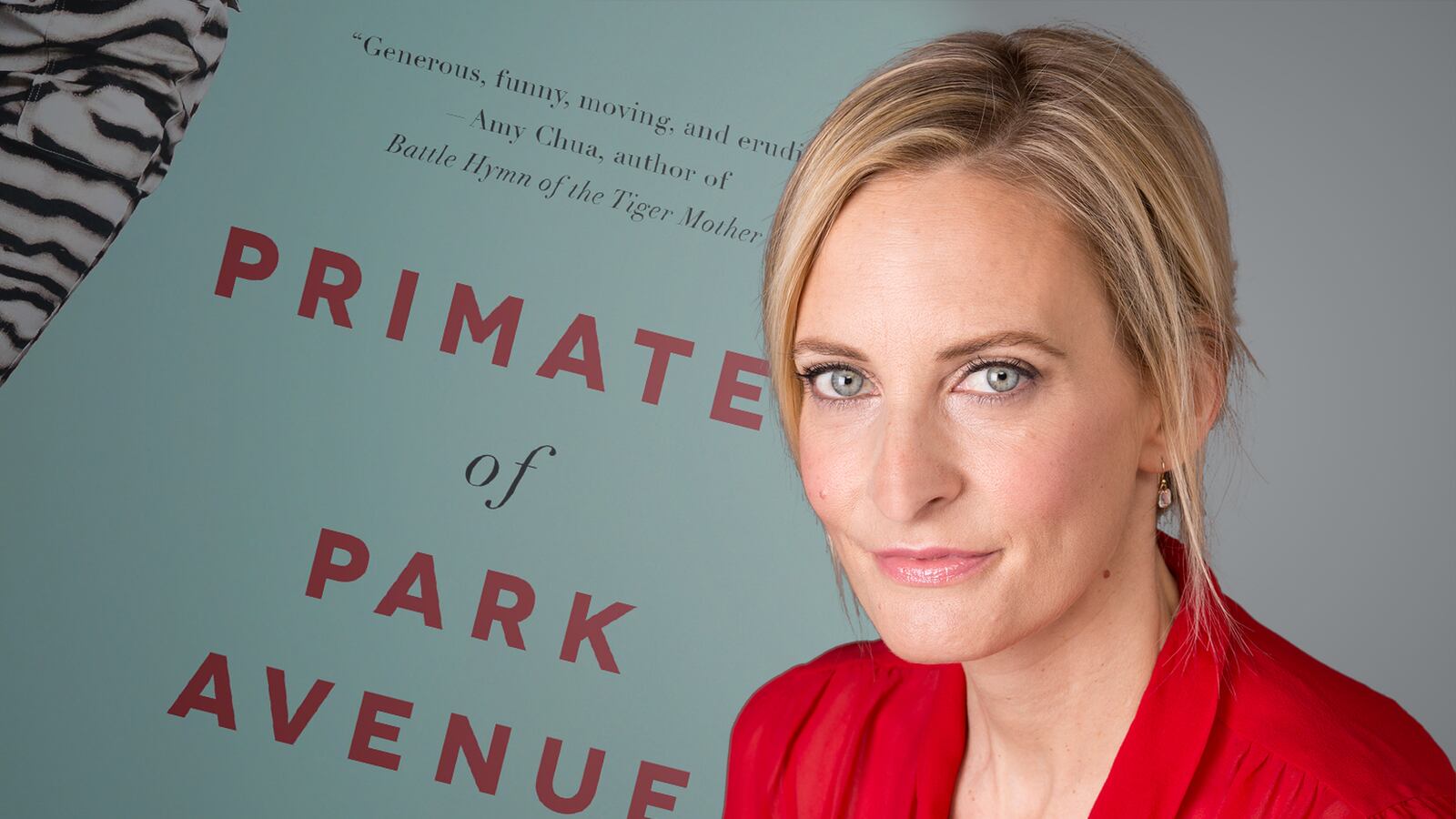From the outside, the lives of the perfectly polished princesses of Manhattan’s Upper East Side might seem irrelevant to those of us who don’t hop between Aspen, Miami, and the Hamptons on private jets, or send our kids to elementary schools that cost as much as Harvard.
But Wednesday Martin, author of the new book Primates of Park Avenue, says we can all learn from studying this mysterious tribe: Their wealth might not trickle down, but their values do.
Martin, who has a background in anthropology, spent several years raising her two young boys in the heart of this hyper-competitive world, studying the habits of her fellow mothers. A cultural outsider who is only slightly less wealthy than her subjects, Martin freely admits to “going native,” as symbolized by her demented quest for a coveted Hermès Birkin bag.
Her book has attracted controversy since its release. The New York Post rushed to disprove several details of Martin’s story, particularly its chronology, claiming that Martin and her family spent much less time living on the Upper East Side than the book suggests (Martin counters that she did not claim in her book to live there for six years, but to do fieldwork there for that time). According to Martin, her publisher has since decided to add a “standard author’s note at the beginning that explains how I used narrative techniques commonly used in a memoir in writing this one. The publisher acknowledged it was an oversight not to include it in the first place.” We caught up with Martin (who’s since moved across Central Park to the more laid-back Upper West Side) to ask why her book has touched such a cultural nerve, and whether the rich really are a breed apart.
Why do you think there has been such a rush to discredit your book?
WEDNESDAY MARTIN: Mothers and wealth are tremendous hot button topics, and people love reading about rich people. But people don’t like to feel their secrets have been revealed, even when an author has taken many precautions to protect their privacy—not only by changing identifying details, but also altering some chronologies and leaving time periods unspecified so individuals won’t feel implicated or “pinpointed” by the story. Maybe the book should be filed in libraries and bookstores in the “uncomfortable truths” section—if such a place exists!
I really attribute the backlash to this new kind of misogyny. Our society's important and legitimate discourse about income inequality and disparities of wealth, this important national conversation we are having about income inequality, has a dark underside. There is an asymmetrical anger at wealthy women about it—as if hedge fund wives are the problem, not hedge funders. I think the reception of my book has been caught up in this asymmetrical anger at wealthy women, a sexism masquerading as political enlightenment.
So, do you think the women in your book are happy?
Sure, some of them are really happy and having fun, but there’s an ethos of what I call “tense perfectionism.” It’s hard not to be tense when you’re economically dependent. It’s hard not to be tense when you live in a body-display culture and you have to be perfect all the time. It’s hard not to be tense and kind of joyless when you’re subject to the code of intensive motherhood—how you’re never, for one minute, allowed to let up in your quest to give your child the perfect childhood, because if you let up, you’re a bad mother. Okay, it’s not the same as not being able to feed your kids, but I tried to take it on its own terms and understand it.
People want to talk about how stupid these women are, how they just go to SoulCycle all the time, but there are reasons why a lot of them feel joyless and tense, which I don’t want to dismiss. That’s my modest hope: that people get that it’s not a takedown.
You use the word “perfect” a lot, but obviously the whole point of perfect is that it’s impossible. You can’t have perfect children; there’s no such thing. Do you think that having money—which can get you just about everything else you want—adds to the pressure to be perfect?
What I saw was just that, yes. There was always more that you should be doing for your child, more you should be doing to improve the cultural capital of the couple, more you should do to improve your body. I’m not putting anyone down. I’m trying to understand how these pressures accrue.
A generation ago, marrying a rich and successful man in New York usually meant moving to the suburbs to raise the kids, but your subjects are all living in the city. How does that change their lives?
It’s very different. There’s been a demographic shift: all these wealthy families are staying in New York, consolidating their wealth and growing their families right here in the city, so all of these things are much more on display than they might be if everybody left for a bedroom community. Sometimes the very wealthy kids are going to the same schools as the nearly-wealthy or the middle class, and all these parents are seeing each other. We’re all right here in a densely populated city, living on top of and right next to each other.
So do you think that the pace and hazards of the city, on top of all the pressure of competition, makes the stress worse for these women?
I really thought that if you could afford not just triple-pane windows but a penthouse, to be really far away from the noise; if you could afford weekends at a spa or to get away on a private plane; and the most expensive nanny money can buy, then that would ameliorate the stresses of the city and the stresses of motherhood. But it seems in this case to really have exacerbated them. And for women there’s the added pressure—whether you’re sympathetic to it or not—to be the best, most perfect mother, the sexiest woman, the best dressed woman, and the best possible wife who’s advocating for both her child and the couple’s place on the hierarchy of a very rigidly stratified society.
In your book, the men are really nowhere to be seen. Once upon a time that made sense—the men were in the city, maybe with their girlfriends, and their wives were all out in the suburbs. But now they’re in the city, and the sexes are still segregated. Why is that?
The very first thing that struck me about this neighborhood was the beauty of the women—just how incredibly turned out they were, so that they looked like they were going to Fashion Week when they were going to school drop-off at 8 a.m. But after that, what gave me the most culture shock was the sex segregation. It was astonishing to me and you saw it everywhere, at dinner parties and charity functions—men stuck with men and women stuck with women. They’re together but profoundly apart.
And it starts very early. I remember calling around to summer camps for one of my children when he was maybe four years old, and I wanted to make sure that if he went to camp, he could see his little friends during the day who were girls. So I asked if they’d be in the same group and the person on the phone told me, “Actually, they won’t see each other, because we separate the boys and girls starting at that age.” I asked why and I was told, “Because they have such different interests at those ages.” I absolutely couldn’t believe that the sex segregation starts so young, and it’s institutionalized even at a coed summer camp.
If you look at worldwide ethnographic data, wherever there’s a rigidly hierarchal society where women are economically dependent on men, and there’s sex segregation, you will find that the status of women is low relative to men. So the sex segregation definitely raised my social-researcher antenna. This is a rigidly gender-scripted elite society. Other neighborhoods aren’t like that—downtown is not like that, the West Side is not like that. So it struck me right away that this was a separate world that I really wanted to study and try to understand and write about.
You say it even comes down to what men and women drink—the men drink (and collect) expensive red wine, while the women are drinking white wine, tequila, and vodka—and a lot of it. How do you explain that drinking culture?
The drinking seemed to me to be tribal; it was what women did. And it was an outlet for tension. Of course, a lot of women with children across the country are thinking, “When can I have that glass of wine, when can I have the vodka, when can I self-medicate for the stresses of motherhood?” I thought the stresses of motherhood might decrease with wealth, but in what I observed that was not the case. I think that goes back to intensive mothering, which the sociologist Sharon Hays calls a plague of the privileged—needing to be that perfect mother and enhance your child’s life on every measure all the time.
It’s strange because these women have usually been to elite colleges, where campus life is generally quite gender-mixed. Did it surprise you that women would go through that type of education and then come out the other side willing to stay at home and have ladies-only lunches?
People have said to me, “Why don’t you talk about the women who work on the Upper East Side?” Well, because I couldn’t do field work with them! They were going to work. These mommies were hanging out and going to charity events together and at the playground together and at playgroup together with their kids, and that’s why I was doing a study of non-working moms.
As to the not working, I really don’t put them down for making that choice. Especially when you’re wealthy, are you really going to avail yourself of what in our country is unfortunately often not high-quality daycare? Are you going to feel good, if you can afford to stay home, with a nanny whom you haven’t had a lot of help with screening and you are not 100 percent sure about? There are some great nannies, but there are also some not-great nannies. How is it that you’re going to override the tremendous cultural pressure that you feel and the pressure as a mother that if you can stay home, you had better? There are reasons that women have these advanced degrees but they’re staying to watch their kids, and some of the reasons are just rooted in the larger culture and it’s a simple thing that affects everyone: there isn’t great childcare in this country.
It seems that a lot of intellectual energy that’s left over is then going into essentially voluntary labor for the schools, the charities, and everything else. What’s the impact of that?
I call that “Mommynomics.” I believe that these women are doing important work, but at the same time I think there’s a dark underside to it, that they feel compelled to do it for a number of reasons, say, because they want to get their kids into good schools. There’s a certain level at which it’s exploitation not to pay these women for the skills that they’ve honed in graduate school or their previous professions. It suppresses the value of women’s labor.
That brings up the question of the notorious “wife bonus.” Does it really exist?
In addition to the people who spoke to me about them for my book, I continue to hear, as recently as a few days ago, from people telling me about financial gifts, compensations, thank-you payments, annuals and allowances in their marriages. Some people who receive such payments don’t call them “bonuses.”
It could be seen in a positive light, as a version of what many feminists have long advocated: a salary for childcare and all the work women do at home. So why do you think the bonus attracted such controversy?
This is one of the many strange-seeming things these women told me about when I asked them to tell me about their lives and their culture. I didn’t even think it was the strangest thing. But so many people are talking about it now and posting about it online: “I get a bonus,” “I don’t get a bonus,” “I think it’s appalling,” “I think it’s great,” “Can I get one?” etc. It’s interesting that so many people are talking about it and it triggered—this is the real issue—the question of economic dependency in a marriage. How much autonomy do you have in your marriage if you’re married to a rich, powerful man but you don’t work? That was really what I was trying to ask.
I think the reason it got so inflamed is because people are really shaken by the idea that a woman married to a rich, powerful man could be disempowered not only relative to her husband but also relative to a middle-class woman who works. I think that idea really stuck in people’s craw.
It’s one of the many ways in which, as you mention in the book, this world seems like something out of an 18th century novel. Do you think it’s any more progressive than that?
Elite cultures in society are sometimes progressive but, they’re often very conservative and even retrograde, and in many instances this world struck me that way—from the sex segregation to the traditionally gender scripted roles of the women staying home and the men working. Of course this was because these women were at this life stage where they had young children. Once their children are getting older and getting ready to be in school full time, there was a whole discussion about working outside the home.
There were no “mommy wars”—they didn’t dislike women who worked, nor were they wary of them. I think in that way they’re just like a lot of other women across the country who stay home for a while and then have to think about getting back into the game. It might be that they would decide to redouble their work for their charitable causes or it might be that they go back to a career that they had put down, but it was definitely something these women were talking about.
The book takes a turn at the end to talk frankly about the loss of your baby. What did that experience reveal to you about these women that you hadn’t previously seen?
I did definitely feel that that terrible experience was something that connected me to other women and new friends in a profound way. It was a moment where I realized that a lot of these behaviors that seemed so hard to understand, so crazy—a lot of them were emerging from this fundamental human anxiety. Sometimes, “What if I don’t do a good enough job for my child?” was masking the universal fear, “What if my child dies?” And when I realized that, I felt that these women who are in many ways so different are in one way not at all different from other women, other mothers.
Read an excerpt from Wednesday Martin’s Primates of Park Avenue:
The first time I really noticed it happening, I was headed back home after a quick trip to the corner market. Swinging a plastic bag of bananas and a carton of milk by my side as I made my way from Madison toward Park on East 79th Street, I felt expansive and happy. The sun was out and the wide sidewalk was
remarkably uncrowded. It was a lull period—morning rush hour over, not yet lunchtime—and there was hardly anyone out and about in our normally bustling neighborhood. For a Midwesterner accustomed to space and quiet, it felt, momentarily, a little bit like home—only with elegant prewar buildings and doormen in upbeat moods saying hello as you walked by. My son was in a good school. He had school chums, a social life, if you will, and so, by extension, did I. Sure, I wished the moms were a little friendlier, and I still felt distinctly on the outside most of the time when I dropped my son off and picked him up. But I was a good enough mother of one, with another on the way. I was finally finding my way and my place on the Upper East Side, it seemed, and on this day I was pleased.
Half a block ahead I saw a solitary, well-dressed woman striding purposefully toward me. We walk briskly in Manhattan, and in no time she (perhaps in her mid-50s) and I (late 30s) were closing the space between us. In keeping with Manhattan sidewalk etiquette—more like a traffic law, really—I did as cars and New Yorkers do and kept to the right. So why was this welldressed, well-coiffed woman drifting to her left, directly into my path, with every step? Were we in England?
I adjusted to the right again, and yet again, to give her even more room as she continued her course toward me. If I kept moving to the right as she was quite clearly forcing me to do by bearing down on me in this way, I realized, I would walk directly into the big orange metal trash can now several steps in front of me. This was ridiculous, I thought, surveying the entire wide, empty sidewalk and slowing down. Just before the trash can, I came to an abrupt halt (what choice did I have? Dart in front of her to the other side of the sidewalk entirely?) and looked at her, for she was a mere six inches away from me now, in spite of the vast expanse to her right. She caught my eye and held my gaze while she deliberately and not at all gently grazed my left arm with her magnificent bag. Then she smirked—she actually smirked!—and continued her purposeful brush past me. I turned around to watch her back recede down the sidewalk, breathless with surprise that she had done what she had done. Whatever it was. What was it?
I had been charged. At least that is how it felt to the anthropologist in me, who in my undergraduate days had watched hours of documentary footage of chimps coming toward one another with aggressive bearing and intent—arms swinging, teeth displayed, emitting screeches and guttural vocalizations. Unpacking my groceries, I played back the encounter in my mind, feeling uneasy, irritated even. What the hell was going on? I realized, now that I thought it through, that this kind of thing had happened before—a woman taking the measure of me and then crowding me—but never quite as explicitly. It was time to start paying attention, really paying attention, to Upper East Side primate social behaviors.
Sure enough, I began to notice similar encounters unfolding all around me. In uptown crosswalks and upscale boutiques and the waiting room of a famous cosmetic dermatologist, I perceived that, subtly and not so subtly, women dressed to the nines not only took the measure of but also “charged” other women. Not infrequently, one of those other women was me. Sometimes, in these encounters, I actually had to step aside toward the curb or flatten myself against the wall of a building to allow a woman to stride by me, so adamant was she in her refusal to budge or swerve a fraction of an inch from her course, a course that had been altered as if to tell me … something. What, I wondered, did the woman who charged want the woman she was charging to do?
My previous territory, the West Village, was mere miles away, but another country, apparently, when it came to uniforms, customs, and warfare between women. Sure, I recalled now, once in a while down there you would encounter a blank-faced, freakishly tall supermodel striding down the narrow, buckling strip of concrete that ran alongside Bleecker Street as if it were her own personal catwalk. But that was just a professional narcissist doing what she did. Stepping out to run a quick errand on the Upper East Side, on the other hand, you could find yourself embroiled, unwittingly, in a remarkably antagonistic and neatly gendered game of chicken, in which one apparently high-functioning, well-dressed and otherwise-normal-seeming woman asked another, Who’s going to move first?
After a few weeks of watching and walking about while tuned in to the charging phenomenon, the female pedestrian in me was thoroughly inside the experience, constantly alert and ready to joust when out for a walk or en route from one place to another. But my inner social researcher wanted more data. And so, early one morning, having dropped my son off at school, I bought a coffee and parked myself in front of a doorman building in my neighborhood, and I watched. The next day and the next and the next I stood outside a store, and then near an intersection with real foot traffic. A few times I actually made observations inside buildings frequented by women, or rather the entrances to them, since entering and exiting seemed to be highly fraught and contentious moments when charging was likely to happen—high-end retail shops, a restaurant known to be the native habitat of a cross section (age-wise) of ladies who lunch, and a few lobbies.
Eventually, I observed nearly a hundred of the type of encounter I had that day on East 79th Street. My research was informal, of course, but I did come to some conclusions. Chief among them: women on the Upper East Side, particularly women in their thirties and women on the downhill slope of middle age, are utterly attuned to and obsessed with power. In many but not all of the encounters I observed, it was an older woman who “charged” a younger one, moving toward her until a kind of social crisis point was reached, when actual impact was avoided—often at the last second—as the younger woman quickly moved aside. The actors in these scenarios then unfailingly continued as if unaware of the (non-)exchange that had taken place between them. It was as if both players were complicit in some deep sense, agreeing to agree that what had just happened hadn’t.
Over and over, I watched encounters unfold, until an explanation began to take shape about women and their bids to assert their dominance over other women. It was their right, they said as they charged, to expand their space by forcing others to give it up. Their message, when I had observed enough of these bencounters, was pretty clear. It was not simply “Get out of my way” but something more pointed: “I don’t see you. Because you don’t even exist.” Their handbags—heart-stoppingly beautiful and expensive-looking affairs slung across or hanging from their shoulders or dangling from their hands, quilted and dyed, snakeskin and lambskin and ostrich, with interlocking Cs or Fs or intricate buckles and locks—apparently had a lot to do with it. They were armor, weapons, flags, and more, it seemed: everyone who charged someone seemed to have a fantastic bag, and to revel in brushing her opponent with it. This was the coup de grace.
The late Nora Ephron wrote that people in LA have cars, and we in Manhattan have our handbags, and these encounters between women brought new meaning to this analogy for me. If handbags are our cars, as Ephron suggests—at once functional and utterly symbolic, our attempt to get ourselves and our stuff from point A to point B and also to be seen as we hope to be seen as we traverse the town—then, it seemed to me, all along the uptown avenues of affluence there was plenty of road rage. With nothing but a plastic bag from the grocery store on my arm, I had been asking for it.
I thought, too, of the dominance displays of Mike, a chimp in Jane Goodall’s Gombe troop. Mike is legendary among primatologists and students of anthropology for having shown the kind of remarkable resourcefulness that can reorder the world, or at least upend an entire, well-established social hierarchy. Small and low ranking, Mike was a relatively new transfer to the troop when Goodall arrived in 1960; she observed that he often took a beating, literally, from the older and bigger chimps of Gombe. His life was that of a miserable, stepped-on outsider, an ostracizednewcomer to the party.
And then, Mike got himself a beautiful purse.
Actually, he discovered a couple of empty, discarded, lightweight metal kerosene canisters with handles. And brilliantly, he realized he could incorporate these props into his dominance displays—choreographed performances in which male chimps seek to intimidate and impress the chimps they live with, without actually harming them. Usually in a dominance display chimps chase or body check one another, further making their point by shaking branches, slapping the ground, and throwing rocks, all the while issuing loud pant-hoot calls and excited screams.
Primatologists and wildlife photographers have frequently been on the receiving end of such dominance displays and report that they are startling, even terrifying. So imagine the surprise of the Gombe troop members when Mike came running at them dragging big, noisy unfamiliar things by their handles, banging them and swinging them through the grass like scepters. And then further enhanced his display by standing tall in the middle of the group and crashing the mysterious objects together, making an unholy, previously unheard-of racket that seemed to say, Now I own you! This groundbreaking social spectacle sent even Goliath, the reigning alpha male, into a cowering panic. The researchers of Gombe quickly removed the canisters, to little effect. The other chimps remained in utter awe of Mike, who rapidly dethroned Goliath in spite of his high-ranking supporter, the former alpha male David Greybeard, to become alpha chimp himself. For five entire years. Such was the powerful half life of a great handbag.
I could not change or beat them, and no, I certainly could not and did not want to join these Mean Girl Moms west of Lex. Or maybe I did and could, kind of. What I needed was a kerosene canister of my own. Yes, something about these arrogant women, who pushed and crowded me as though I didn’t exist, let alone matter, made me want a beautiful, expensive bag. Like a totem object, I believed, it might protect me from them, these ladies who were everywhere in my adopted habitat and who said so much without a word, using only their eyes and their faces and, always, their handbags. Perhaps, I thought, a nice purse like the ones they had might trick them, mesmerize them into believing that they oughtn’t challenge me to sidewalk duels and all the rest. That it would be worth it to say hello, when we saw one another at a party or in the school halls or at a restaurant, without giving me a disdainful once-over. Plus, I reasoned, it might annoy them. With a gorgeous bag, I thought, I would not just have a sword and a shield. I would have something that they did not have, or something that they wanted, or something that they did have and didn’t want anyone else to have. I imagined the Queen of the Queen Bees trying to brush by me and getting stuck in her gut with my boxy Birkin. Really, you couldn’t put a price on that.
From Primates of Park Avenue by Wednesday Martin, copyright ©2015 by Wednesday Martin. Reprinted by permission of Simon & Schuster, Inc.






